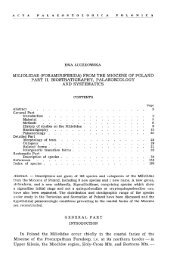Full text - Acta Palaeontologica Polonica
Full text - Acta Palaeontologica Polonica
Full text - Acta Palaeontologica Polonica
Create successful ePaper yourself
Turn your PDF publications into a flip-book with our unique Google optimized e-Paper software.
334 ACTA PALAEONTOLOGICA POLONICA 56 (2), 2011<br />
cent stripes (Fig. 2I). The transition between the two levels of<br />
colouration is diffuse. The stripes are located on the adapical<br />
part, median part and adbasal part of the whorl. Their width is<br />
almost equal in the youngest specimens, but the median one<br />
becomes broader in most adult specimens. Some young<br />
specimens display a fourth spiral stripe around the umbilicus<br />
on the base of the shell.<br />
Ampullina perusta (Defrance in Brongniart, 1823)<br />
Fig. 2J, K.<br />
Stratigraphic and geographic range.—Middle Eocene, Lute−<br />
tian–Bartonian (Italy).<br />
Colour pattern description.—The pattern consists of two<br />
levels of residual colouration: a pale heterogeneous back−<br />
ground with several dark spiral stripes. Sometimes, there is<br />
only a group of two or three thin stripes very close to each<br />
other, of a variable width (Fig. 2J), on the median part. There<br />
is sometimes an additional broad adapical stripe (Fig. K).<br />
Comments.—The residual colours in this species are observ−<br />
able in natural light and are obviously different from those of<br />
the other species. This is the result of a different type of pres−<br />
ervation of the colour pattern. It is also interesting to note that<br />
this pattern appears as the negative of the residual colour pat−<br />
tern on the other shells and that the dark elements in this spe−<br />
cies correspond to the fluorescent ones in UV light observa−<br />
tions.<br />
Ampullina intermedia (Deshayes, 1832)<br />
Fig. 3A–E.<br />
Stratigraphic and geographic range.—Early Eocene, Ypre−<br />
sian (Cuisian) (PB).<br />
Colour pattern description.—The pattern consists of four<br />
levels of residual colouration. The background is heteroge−<br />
neous with three spiral slightly fluorescent stripes, one on the<br />
adapical part, one on the median part and one on the adbasal<br />
parts of the whorl (Fig. 3A). The apex is pale and there are<br />
small fluorescent patches superimposed on the background<br />
(Fig. 3A–C). The transition between the levels of colouration<br />
of the background is diffuse. The background is homoge−<br />
neously dark in some specimens (Fig. 3B–E). The small<br />
patches of varying size do not have a definite shape and their<br />
distribution is irregular (Fig. 3B). The coalescence of the<br />
patches sometimes produces fluorescent sinuous axial seg−<br />
ments (Fig. 3D, E). This residual colour pattern is very simi−<br />
lar to those of A. merciniensis (Deshayes, 1864) (Fig. 3F)<br />
from the Ypresian (Cuisian) of the Paris Basin and Ampul−<br />
lina lignitara (Deshayes, 1864) from the Ypresian (Spar−<br />
nacian) of the Paris Basin and Hampshire Basin.<br />
Comments.—Former authors (Cossmann 1888; Wrigley<br />
1946; Glibert 1963) considered the three species Ampullina<br />
intermedia (Deshayes, 1824), A. lignitara (Deshayes, 1864)<br />
and Ampullina merciniensis (Deshayes, 1824) as belonging<br />
to the genus Crommium. In the original description of the ge−<br />
nus, Cossmann (1888) however stated, that the sheath is ab−<br />
sent whereas it occurs in each of the three aforementioned<br />
Fig. 3. Species of the genus Ampullina Bowdich, 1822, under UV light.<br />
A. Ampullina intermedia (Deshayes, 1832), MNHN A30418 (MNHN coll.),<br />
Cuise−la−Motte, Oise, France, Ypresian (Cuisian), in ventral (A 1) and dorsal<br />
(A 2)views.B. Ampullina intermedia (Deshayes, 1832), MNHN A30416<br />
(MNHN coll.), Cuise−la−Motte, in ventral (B 1) and dorsal (B 2)views.C. Am−<br />
pullina intermedia (Deshayes, 1832), MNHN A30415 (MNHN coll.), Cuise−<br />
la−Motte, in labral view. D. Ampullina intermedia (Deshayes, 1832), MNHN<br />
A30417 (MNHN coll.), Cuise−Lamotte, in labral view. E. Ampullina inter−<br />
media (Deshayes, 1832), MNHN A30422 (d’Orbigny coll.), Cuise−Lamotte,<br />
in dorsal view. F. Ampullina merciniensis (Deshayes, 1864), MNHN J02199<br />
(Cossmann coll.), Mercin−et−Vaulx, Aisne, France, Ypresian (Cuisian), in<br />
dorsal view. Scale bars 10 mm. Photographs by C. Lemzaouda and P. Loubry<br />
(MNHN).<br />
species. Thus, A. intermedia, A. lignitara, and A. merci−<br />
niensis are, here, no longer considered to belong to the genus<br />
Crommium. Furthermore, these species with closely related
















